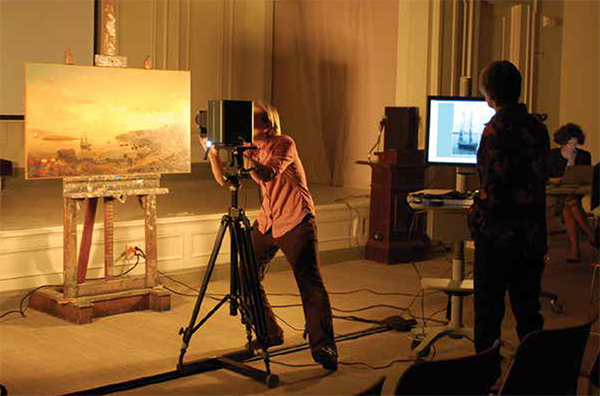By Museum Curator Martha Oaks, August 2020
Fitz Henry Lane, the Early Years
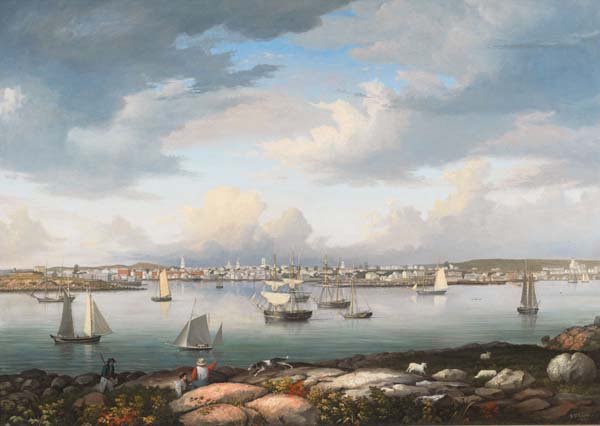
Fitz Henry Lane, View of Gloucester from Rocky Neck, 1844. Oil on canvas. Cape Ann Museum, Gloucester, Mass., Gift of Mrs. Jane Parker Stacy (Mrs. George O. Stacy), 1948 [1289.1a]. Visit fitzhenrylaneonline to learn more about this painting.
Fitz Henry Lane was born Nathaniel Rogers Lane on December 19, 1804 here in Gloucester, a son of sailmaker, Jonathan Dennison Lane, and Sarah Haskell Lane. Lane’s ancestors were among the earliest settlers on Cape Ann, the Lanes originally residing in what is now the village of Lanesville and the Haskells in Gloucester’s West Parish.
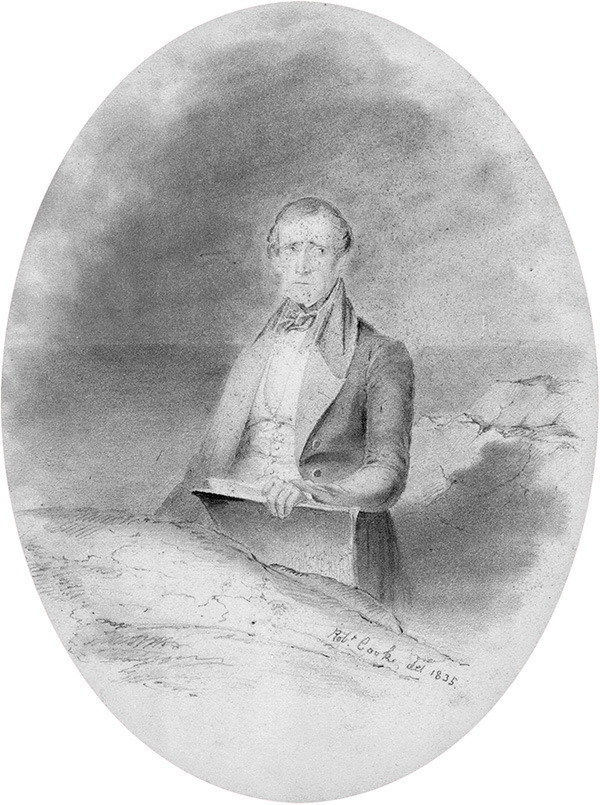
Gloucester was a bustling seaport during Fitz Henry Lane’s childhood. Since the 1750s, commerce had been concentrating around the Inner Harbor, luring residents from outlying neighborhoods to the waterfront and to maritime-based jobs. Streets had been laid out, and houses, schools, meeting houses and waterfront structures erected. Ships of all sizes and rigs filled the harbor, engaged in harvesting cod, mackerel and other species, processing it and shipping it around the world. By the 1820s when Lane was a young man, most of the town’s population lived and worked in Gloucester’s Harbor Village and the town was quickly becoming one of New England’s leading seaports.
Although much research has been done into the narrative of Lane’s early life, few specifics have been documented. It has long been known that his ability to walk was impaired at an early age, leaving him lame, as one contemporary described it, and needing the use of crutches. The cause remains unclear as does exactly how impaired Lane was. Questions also remain about Lane’s formal education, jobs he may or may not have held as a young man and what exposure he may have had to art. In 1831, for reasons which are similarly mysterious, Lane petitioned the Massachusetts General Court and was granted permission to change his name from Nathaniel Rogers Lane to Fitz Henry Lane. A year later, at the age of 27, Lane moved from Gloucester to Boston to assume an apprenticeship at William S. Pendleton’s lithography firm and lay the foundation for his career as an artist.
(above) Fitz Henry Lane at age 31 by Robert Cooke, 1835. American Antiquarian Society.
Drawn from Nature & On Stone
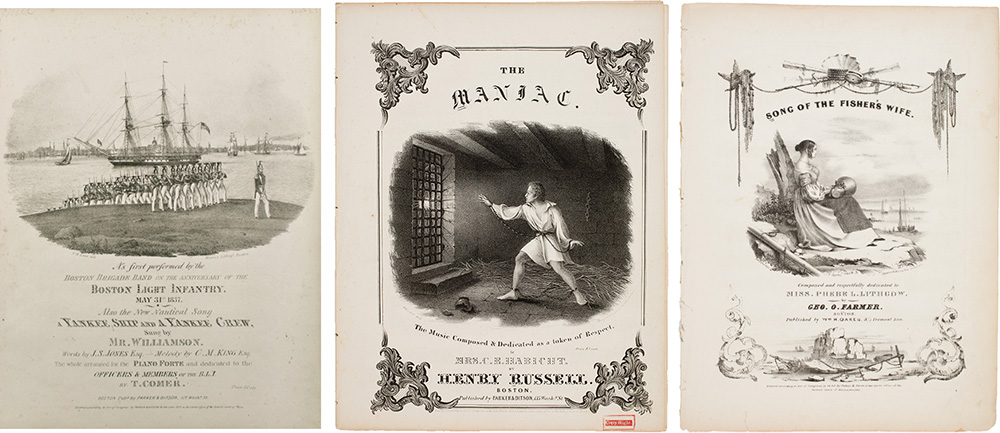
(left) Captn. E. G. Austin’s Quick Step “Yankee Ship and a Yankee Crew.” Lithograph on paper (sheet music). Drawn by F. H. Lane. Lithograph by Moore’s Lithography, Boston, 1837. Published by Parker & Ditson. Collection of the Cape Ann Museum. Gift of E. Hyde Cox, 1994. (center) The Maniac. Lithograph on paper (sheet music). Drawn by F. H. Lane. Lithograph by Thayer’s Lithographic Press. Published by Parker & Ditson, Boston, 1840. American Antiquarian Society. (right) Song of the Fisher’s Wife. Lithograph on paper (sheet music). Drawn by F. H. Lane. Lithograph by Sharp & Michelin Lithography. Published by Oakes & Swan, Boston, 1840. American Antiquarian Society. Visit fitzhenrylaneonline to learn more about Lane's work as a lithographer.
Fitz Henry Lane worked from 1832 to 1837 at Pendleton’s lithography shop in Boston—the longest lived and most successful lithography firm in America. Lane then moved to the printing workshop of Keith and Moore and by 1845 had established his own partnership with J.W.A. Scott. With a natural talent for drawing, Lane excelled in the field of lithography, creating illustrations that appeared on business trade cards, advertisements and sheet music covers. He also created panoramic views of towns around New England and, on occasion, illustrations for books including John James Babson’s History of the Town of Gloucester, Cape Ann published in 1860.
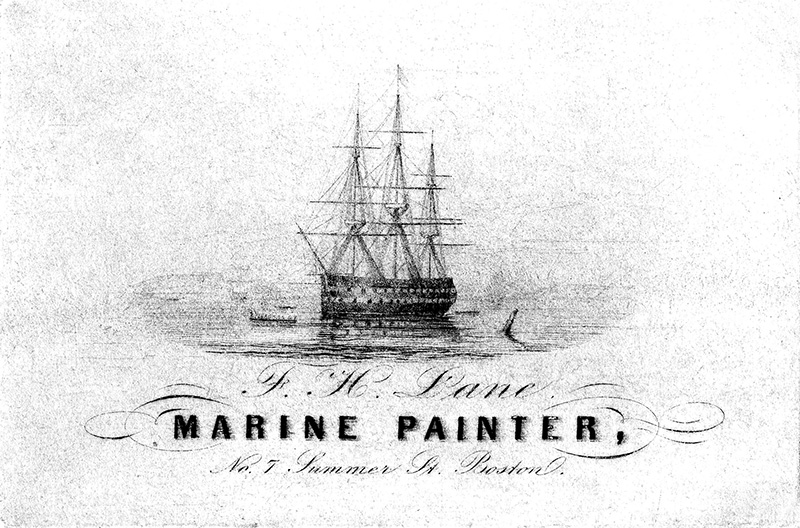
In 1835, while at Pendleton’s, Lane began work on a drawing that would be transformed into a richly detailed lithographic view of Gloucester as seen from its eastern side of the harbor. The scene encompassed virtually all of town’s waterfront with wharves and buildings carefully delineated against a backdrop of sun bursting through the clouds. Clearly intended for the local audience, the work was praised by people on Cape Ann for its extreme accuracy and for its beauty. Perhaps most importantly, the work foreshadowed the skill Lane would quickly perfect of creating works of art which were both faithful to detail as well as idealized renderings. He did two subsequent lithographic views of Gloucester in 1846 and 1859.
Fitz Henry Lane remained immersed in the Boston art scene through the early 1840s, honing his drawing and lithography skills and increasingly turned to painting. He absorbed all he could from artists working around him, particularly Robert Salmon, an accomplished English marine painter who lived in Boston from 1828 to 1840 and had a large clientele of New England captains and ship owners for his work. By 1841, confident of his abilities, Lane had a small business card produced advertising himself as a “marine painter.” Shortly thereafter he began exhibiting his paintings at venues around Boston including the American Art-Union and the Boston Athenaeum. While he would continue to work in the field of printmaking for the rest of his life, by the mid-1840s, Fitz Henry Lane was focusing more on painting and preparing to return to Gloucester.
(above) Fitz Henry Lane’s business card, c. 1841. Collection of the Cape Ann Museum.
Cape Ann at Mid-Century
Owing to the prosperity of the fishing business last season, and the notoriety which Cape Ann is gaining as a watering place, our little village has presented rather a thriving appearance this spring. Quite a number of dwelling houses have been erected in various places; two or three new wharves have been run out; and many new vessels have been added to our fleet. A slight advance has been made in the value of real estate; and appearance have indicated an increase of business ….
—Gloucester Telegraph, June 6, 1846
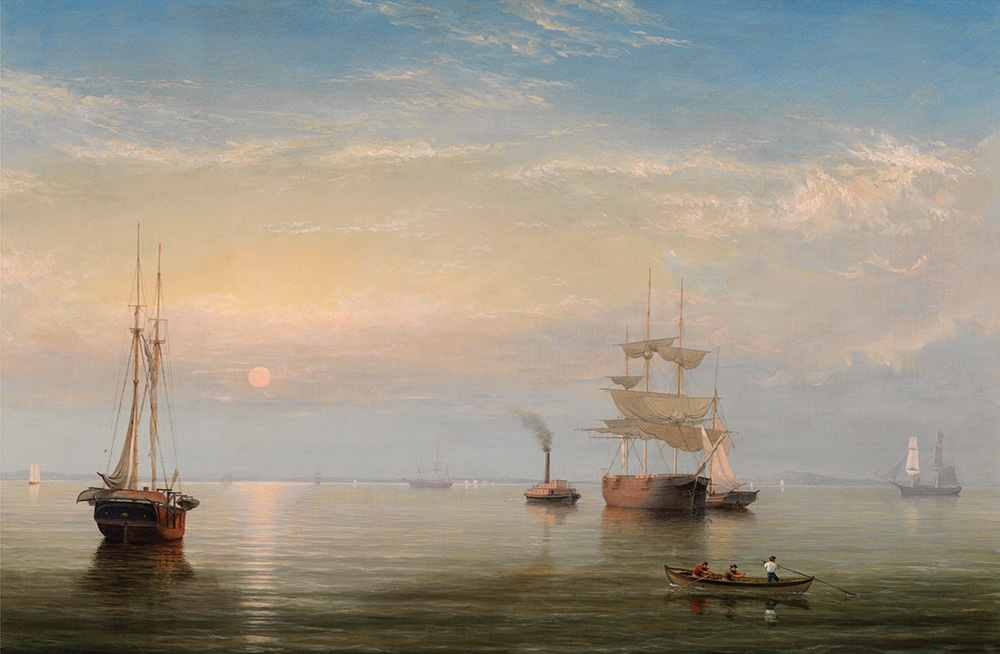
A Calm Sea, c. 1860. Oil on canvas. Collection of the Cape Ann Museum, 1932 [642.13b]. Visit fitzhenrylaneonline to learn more about this painting.
In the autumn of 1849, Fitz Henry Lane purchased a small piece of property in Gloucester on Duncan’s Point overlooking the Inner Harbor. A house with a studio on the third floor was soon erected and the artist (along with his sister and her family) took up residence in 1851. Built of what can only be Cape Ann granite, the structure, still standing today, was distinct from surrounding ones with its austere façade featuring an array of different sized and shaped granite blocks and its distinctive seven gables. From his studio Lane had panoramic views of the harbor and all the activity within it. His view stretched from Five Pound Island at the Head of the Harbor, to Harbor Cove and The Fort, and out to Ten Pound Island and the Western Shore. It was from his perch on Duncan’s Point that Lane created his finest works, masterpieces which captured the prosperity of the town, the harbor and the fleet in great detail and beauty.
![]()
In the years Lane had spent in Boston, Gloucester and Cape Ann had grown and prospered. The coasting and foreign trades were both successful making many local merchants and their families wealthy. Similarly, the fishing industry and the granite trade were expanding steadily, creating jobs that lured workers to the area from across New England and, eventually, from around the world. In 1847 the railroad arrived in Gloucester, linking the town to Boston and beyond, and the summer tourist trade took hold. Fitz Henry Lane immersed himself in his hometown, finding inspiration for his paintings at every turn and a steady stream of patrons willing to purchase his works. Drawing on all he had learned during his time in Boston, Lane quickly made a name for himself as a marine artist.
(above) The Pavilion Hotel and Beach from The Fort, c. 1870. Collection of the Cape Ann Museum.
Gloucester’s Town Green
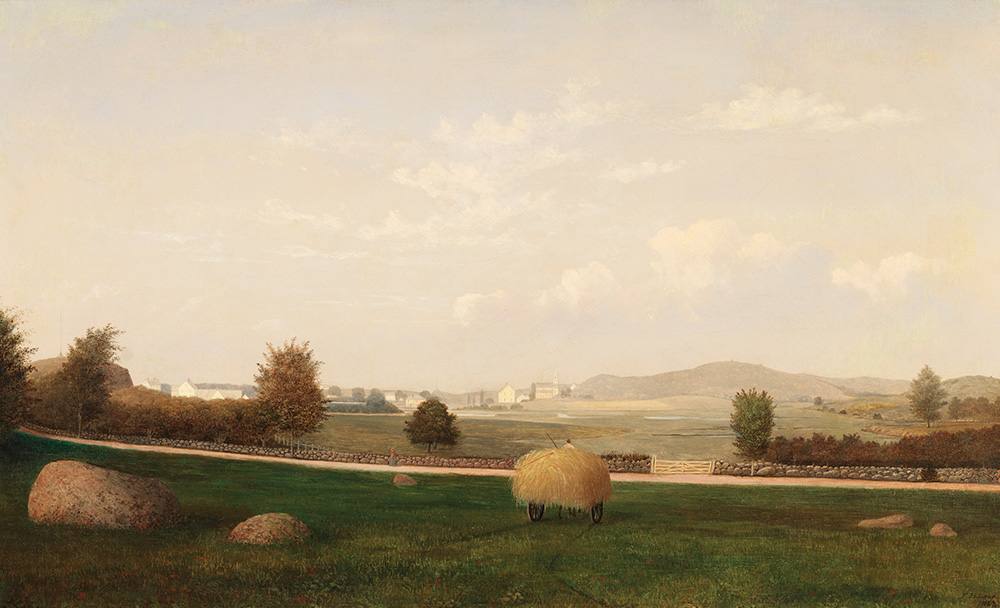
The Babson Meadows at Riverdale, 1863. Oil on canvas. Collection of the Cape Ann Museum. Gift of Roger W. Babson, 1937 [779.03]. Visit fitzhenrylaneonline to learn more about this painting.
From the 1640s through the 1750s, Gloucester’s Town Green was the center of the community, home to a meetinghouse where civic and religious matters were attended to, a town landing where residents could freely access navigable waters, and a pound where stray animals were kept. There were also streams and tidal ponds nearby whose power could be harnessed and used to run lumber and grain mills. In selecting this site to be the Town Green, English settlers were likely following settlement patterns laid out by Indigenous people who lived and worked on the land before they were displaced by Europeans.
The Cape Ann Museum has owned property at Gloucester’s Town Green since 1947 and in 2019, acquired the yellow gambrel-roofed house shown in Lane’s painting Babson and Ellery Houses, Gloucester. In 2020, the Museum completed construction of a state-of-the art Janet & William Ellery James Center adjacent to the Babson House and the almost four-acre site at the gateway to Gloucester known as the Cape Ann Museum Green. By opening old doors to new possibilities, CAM Green addresses the Museum’s need for expanded collection storage, exhibition and community programming space, creating entirely new opportunities to engage, excite and connect.
In crafting landscape plans that would unify CAM Green, Museum leaders looked to Fitz Henry Lane’s drawings and paintings of the site for guidance and inspiration. In a time when photography was still in its infancy, Lane’s carefully rendered drawings and paintings as seen here provide valuable information regarding both the topography of the land as it was during the mid-19th century as well as the evolving use of it. Stone walls and fences are shown in detail as are houses, barns and outbuildings. Lane’s capturing of these key details has greatly informed the Museum’s creation of CAM Green as a site cognizant of our collective history and committed to representing Cape Ann of yesterday, today and tomorrow.
Currents of the Universal Being Circulate Through Me
Standing on the bare ground—my head bathed by the blithe air, and
uplifted into infinite space—all mean egotism vanishes. I become a
transparent eyeball; I am nothing; I see all; the currents of the Universal
Being circulate through me; I am part or parcel of God.
—Ralph Waldo Emerson (Nature, 1836)
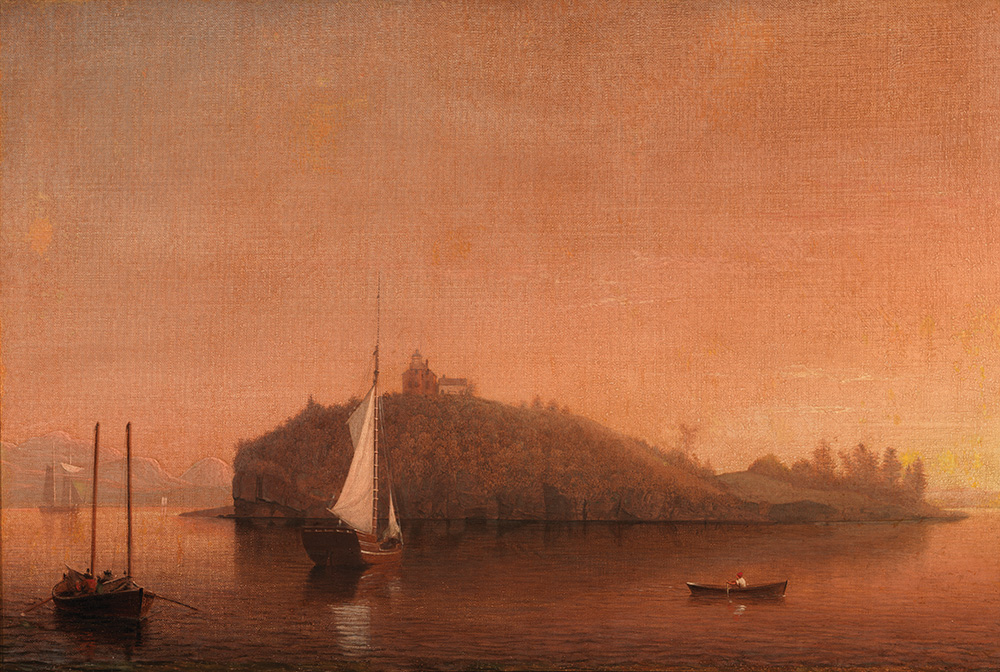
Bear Island, Northeast Harbor, 1855. Oil on canvas. Collection of the Cape Ann Museum. Gift of Alice D. Stevens (Mrs. George B. Stevens), 1964 [1799.3]. Visit fitzhenrylaneonline to learn more about this painting.
Fitz Henry Lane’s life played out during a complex and rapidly changing period in American history. Working in relative isolation here on Cape Ann though against a backdrop of rising social reform movements, increasing industrialization and simmering conflict between federal and states’ rights, Lane pursued his art diligently during the 1850s, turning out a steady flow of refined paintings. In recent years, much has been written about the underlying meaning of Lane’s work during this time, particularly when examined against the national scene. Were his paintings a reaction to the changing world? Was he influenced by writers of the time? Were works done in the late 1850s a response to changes taking place around him such as the coming of the Civil War? Many questions await further exploration and will serve to broaden our understanding of Lane’s art. One of the most thought-provoking of these is Lane’s connections to New England transcendentalist thinking of the day and its effect on his artwork.
When Lane settled into his home on Duncan’s Point in 1849, he immersed himself in the community, taking an active role in civic and cultural events including Independence Day celebrations, tableaux organized in connection with library festivals and other public happenings around Gloucester. Lane also became involved in the Gloucester Lyceum, becoming a member in the mid-1840s and serving as a director in 1849, 1851, 1852 and 1858. It is through his involvement in the Lyceum that Lane had the opportunity for direct contact with Transcendentalists. Organized in 1830 to promote “useful knowledge and the advancement of popular education,” the Gloucester Lyceum hosted numerous lecturers during Lane’s tenure as a director, men who spoke on a range of topics from spiritualism and education reform, to astronomy and “the Yankee character.” Frequent lecturers were essayists Henry David Thoreau and Ralph Waldo Emerson, the most eloquent exponents of transcendentalism—the idea that our understanding of the world comes through individual intuition and imagination and that our knowledge transcends what we can actually see or hear or touch. How these men and their musings affected Lane is impossible to know for certain. However, the parallels between their thoughts and Lane’s paintings are readily apparent particularly in canvases capturing sparse wide-open vistas bathed in luminous light which invite us to view them as a spiritual experience.
Students & Followers
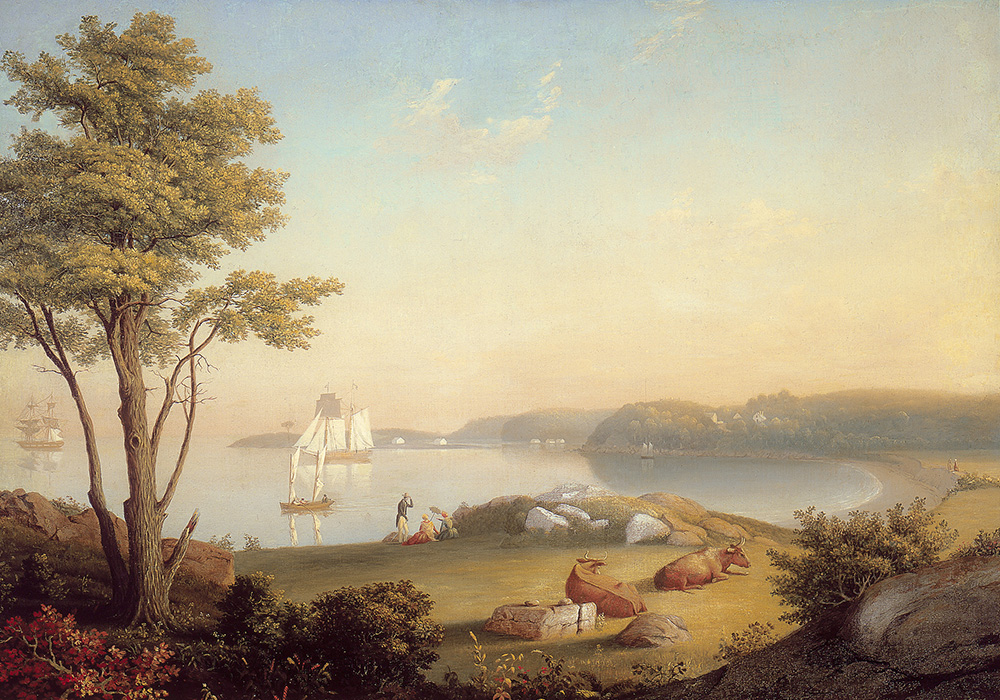
Mary Blood Mellen (1819-1886), Field Beach, Stage Fort Park, c. 1850. Oil on canvas mounted over board. Collection of the Cape Ann Museum. Gift of Jean Stanley Dise, 1964 [2019.2].
Unlike many artists who followed him, Fitz Henry Lane earned his livelihood by focusing on his work as a print maker and a painter, rather than by conducting art classes. Evidence does reveal, however, that Lane had several followers and perhaps even a few individuals who were thought of as students. They included Harriet Phena (Mason) Davis (1823-1874), a niece of one his patrons; George Merchant, Jr. (1828-1906), a fisherman and avid violinist with an interest in art; and Mary Blood Mellen (1819-1886), the wife of a Universalist minister. Of the three, it is Mellen that we know the most about through her surviving work.
Mary Blood Mellen was born in Vermont in 1819 and raised in Sterling, Massachusetts. History tells us that she attended a girls’ academy as a young woman where she studied painting in watercolor. In 1840, she married Universalist minister Charles W. Mellen. In 1855, Charles Mellen’s brother, William R. G. Mellen, who was also a Universalist minister, took up the pulpit in Gloucester and it is assumed that this family connection brought Mary Mellen here and into Lane’s world.
There is no evidence that Mary Blood Mellen was formally apprenticed to Lane, however, his early years spent working in various lithography workshops would have impressed upon him the value of such arrangements – for both the master and the student. By the mid-1850s, it appears Mellen was working alongside Lane who seems to have given her free access to his drawings and even, at times, his canvases to make copies. There is only one known work signed by both Lane and Mellen, Coast of Maine, though there is stylistic evidence that she may have worked on a number of his paintings, not uncommon in an artist-apprentice relationship. While many paintings thought to have been done by Mellen are strongly reminiscent of Lane’s, she had her own distinct palette and her preferred methods of building out and enhancing her compositions. Comparing Lane’s work and those attributed to Mellen, allows us to see these subtle differences between the two artists.
Mary Blood Mellen is often referred to as a “copyist” and it is unknown whether she would have approved or disapproved of that term. It does seem clear, however, that the access Fitz Henry Lane gave her to his work tells us that he saw nothing derogatory in it and that he respected her work as an artist.
Death of a Gifted Artist
The death of this gifted artist may almost be considered a national loss …
—Boston Daily Evening Transcript (August 19, 1865)
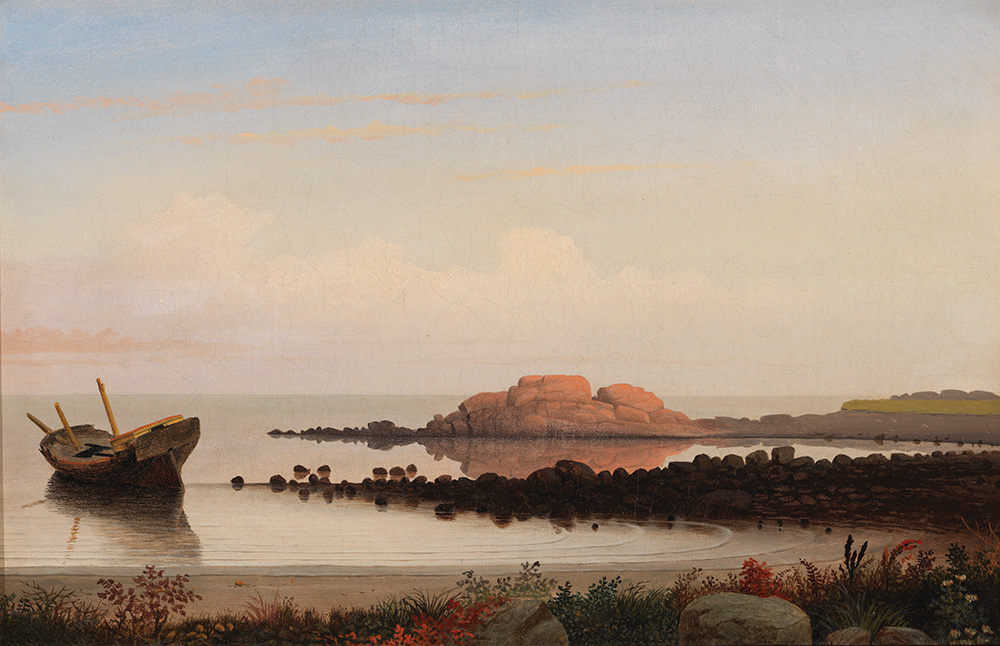
Brace's Rock, 1864. Oil on canvas. Collection of the Cape Ann Museum. Gift of Harold and Betty Bell, 2007 [2007.10]. Visit fitzhenrylaneonline to learn more about this painting.
Fitz Henry Lane died in his home on Duncan’s Point in August 1865 at the age of 61. It was reported that at his death there were at least three paintings in his studio that he was actively working on. Lane was buried in Oak Grove Cemetery here in Gloucester in the Stevens family plot. His grave went unmarked until the 1960s when the Cape Ann Museum had a stone put in place. In his will, Lane remembered several individuals with bequests. It is interesting to note that Lane left Mary Blood Mellen a self-portrait of himself. He also left a wreath of dried flowers that Mellen had made to Caroline Stevens, the wife of his close friend Joseph L. Stevens.
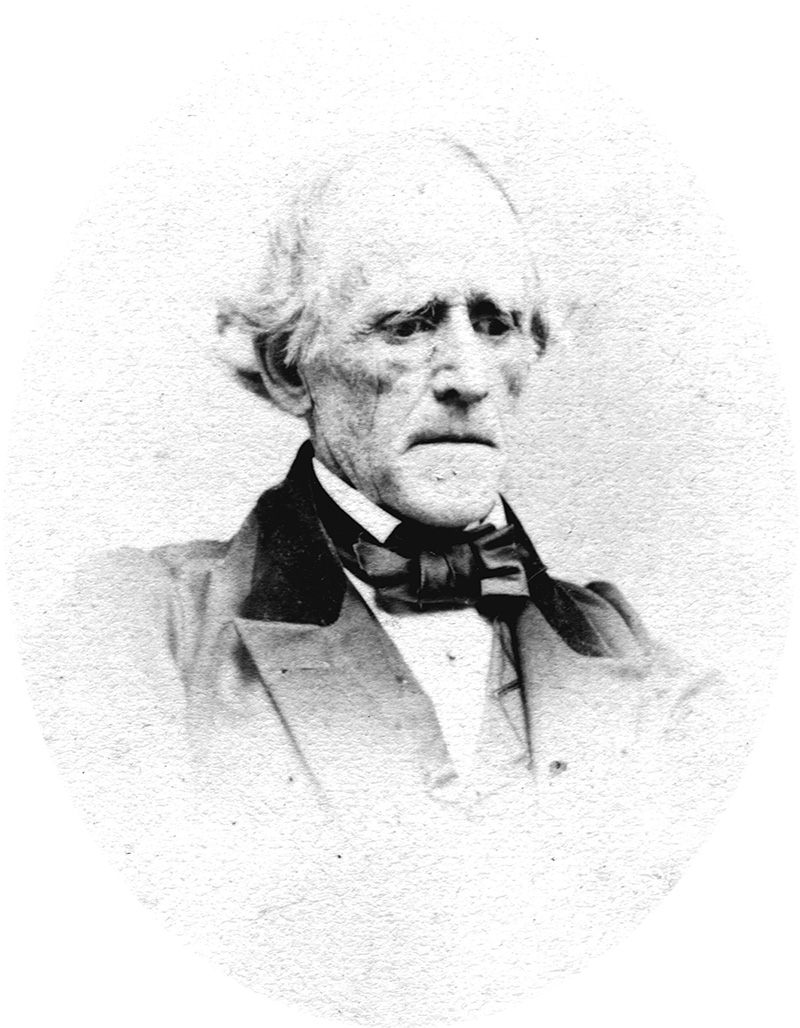
After his death, Fitz Henry Lane slipped into obscurity in terms of the art world as critics and patrons embraced new styles and trends. During the early 20th century, interest in Lane’s works was rekindled by Boston collectors, most notably Maxim and Martha Karolik whose collection is now part of the Museum of Fine Arts, Boston. Families on Cape Ann quickly realized the value of their paintings by Lane, not just in financial terms but also in terms of recording the history of their beloved community. Alfred Mansfield Brooks (1870-1963), long-time president and curator of the Cape Ann Museum, worked diligently with the local community during this time to make sure the best of Lane’s work as well as valuable archival materials related to his life were preserved here in Gloucester.
W. Black Studio. Carte de Visite Portrait of Fitz Henry Lane, c. 1860s. Collection of the Cape Ann Museum.
Related Content
Learn about the process of using infrared reflectology to go "Beneath the Surface" in this essay by art historian Melissa Geisler Trafton. Originally published by the Cape Ann Museum in its fall 2015 issue of Perspectives.
